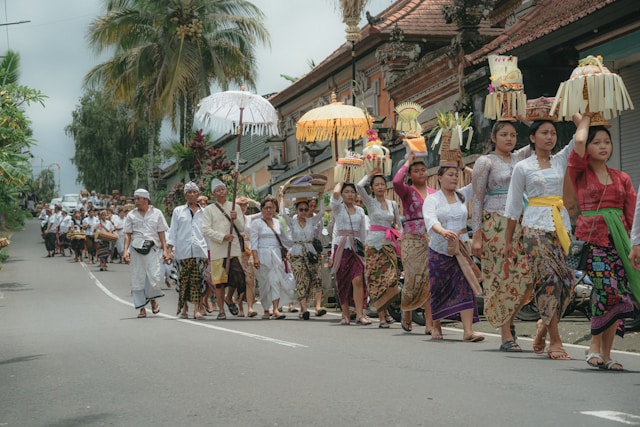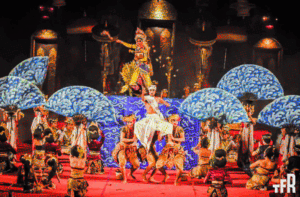The legend of Barong and Rangda comes to life in one of Bali’s most dramatic and captivating dance performances, a sacred spectacle that represents the eternal, cyclical battle between good and evil. As the vibrant sounds of the Gamelan orchestra swell, a magnificent, mythical creature enters the stage, and the air becomes charged with energy. This is a story that is fundamental to the Balinese worldview, and witnessing it is a truly unforgettable experience.
For many visitors, the Barong dance is a thrilling whirlwind of colour, music, and dramatic action. But understanding the powerful story and profound philosophy behind the clash of these two mythical beings can transform the performance from a fascinating spectacle into a deeply moving cultural insight.
As your friendly hosts here at Merusaka Nusa Dua, we’d love to share the story behind this epic tale, so when you see these sacred masks, you’ll understand the powerful forces they represent.
The Characters: Meeting the Forces of Balance
To truly appreciate the dance, we must first meet its two central, powerful figures. They are more than just characters in a story; they are primal forces that represent the very fabric of the Balinese cosmos.
- Barong – The Majestic Protector The Barong is a magnificent, mythical creature, and the undisputed leader of the hosts of good. He appears as a shaggy, lion-like being with a sacred, ornate mask, often with a beard made of human hair adorned with frangipani flowers. Despite his powerful appearance, his character is often benevolent and even playful. He is a guardian spirit, a symbol of health and good fortune, who protects Balinese villages from the forces of darkness and destruction.
- Rangda – The Fearsome Demon Queen In stark contrast, Rangda is the terrifying and powerful queen of the leyaks (witches) and the embodiment of evil. Her mask is fearsome, with bulging eyes, long, sharp fangs, and a fiery, protruding tongue that can be meters long. With matted hair, pendulous breasts, and sharp claws, her appearance is designed to inspire terror. She represents the destructive forces of the world – sickness, death, and dark magic.
The Story Unfolds: A Sacred Drama on Stage
The Barong dance is not just a series of movements; it is a sacred drama that tells a thrilling story of conflict and magic. While local variations exist, the core narrative often follows this dramatic arc.
- The Playful Beginning: The performance often begins with the Barong entering the stage, perhaps accompanied by his friend, a mischievous monkey. He dances playfully, representing a time of peace and harmony in the village.
- The Arrival of Darkness: The atmosphere quickly shifts as the followers of Rangda appear, spreading chaos and dark magic. They may harass the Barong’s monkey friend or disrupt the village’s peace, signaling the arrival of their fearsome queen.
- The Confrontation & The Curse: Rangda herself finally appears in all her terrifying glory. The Barong, as the village protector, immediately confronts her to restore order. A magical battle ensues. In a pivotal moment, Rangda, facing defeat, uses her most powerful black magic to cast a spell on the king’s soldiers (representing humanity), causing them to fall into a trance and turn their own kris (traditional wavy daggers) against themselves in a suicidal rage.
- The Trance of the Kris Dancers: This is the dramatic and famous climax of the performance. Just as the soldiers are about to plunge their daggers into their own chests, the Barong intervenes with his own protective magic. His power makes their bodies impenetrable to the sharp blades. This leads to the famous trance state where the men violently press the daggers against their chests, writhing and shouting but remaining miraculously unharmed, showcasing the protective power of good.
The Deeper Meaning: A Battle That Never Truly Ends
Perhaps the most fascinating and profound part of the performance is how it concludes. A visitor might expect a clear victory where the heroic Barong destroys the evil Rangda, but that is not the Balinese way. Understanding why reveals the heart of their philosophy.
- The Philosophy of Rwa Bhineda: The dance typically ends in a stalemate. The Barong’s magic is strong enough to drive Rangda and her dark forces away, restoring a temporary peace, but he does not—and cannot—vanquish her completely. This represents the core Balinese Hindu philosophy of Rwa Bhineda – the eternal balance between two necessary opposites. There can be no light without dark, no health without sickness, no good without evil. The goal of life is not to eradicate one force, but to constantly strive to maintain a dynamic balance between the two.
- A Ritual to Restore Harmony: For the Balinese, this performance is more than entertainment. It is a sacred ritual, a powerful exorcism ceremony intended to restore and maintain harmony within the village and the cosmos. The masks of Barong and Rangda are considered highly sacred objects, infused with divine energy, and are treated with immense respect.
Where and How to Watch the Barong Dance
Witnessing this powerful performance is a must for anyone interested in delving into the heart of Balinese culture. Here’s how you can experience it.
- Dedicated Venues: The easiest way for visitors to see a high-quality performance is at one of the dedicated cultural centers. Villages like Batubulan, located between Denpasar and Ubud, are famous for holding daily Barong and Kris dance performances specifically for audiences.
- During Festivals: The Barong is a key figure in many temple ceremonies (Odalan) and is often featured as a major performance at events like the Bali Arts Festival (PKB) in Denpasar.
- Booking a Tour: The most convenient way to see a performance is to book a tour, which often includes comfortable, air-conditioned transport from your hotel. Our Merusaka concierge team is the perfect resource for this, and can help you arrange a trip to see a fantastic show.
- Respectful Etiquette: Even at shows designed for visitors, remember you are watching a sacred story. Please do not use flash photography, as it can be very distracting and disrespectful to the performers, especially those who enter a genuine state of trance. Applaud at the end, but maintain a respectful silence during the key dramatic and spiritual moments.
Conclusion: An Epic Tale of Balance
The legend of Barong and Rangda, brought to life through dance, is a captivating spectacle filled with drama, action, and profound meaning. It is a story that reminds us that life is a constant dance between opposing forces. Understanding this incredible narrative transforms what might seem like a confusing performance into a deep and meaningful insight into the Balinese worldview. It is an experience that will surely be a highlight of your cultural journey in Bali.






